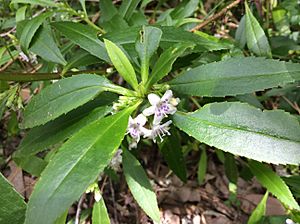Myoporum tetrandrum facts for kids
Quick facts for kids Slender myoporum |
|
|---|---|
 |
|
| Myoporum tetrandrum in the Porongurup National Park | |
| Scientific classification | |
| Genus: |
Myoporum
|
| Species: |
tetrandrum
|
| Synonyms | |
Myoporum tetrandrum, commonly known as slender myoporum or boobialla, is a plant that belongs to the figwort family, called Scrophulariaceae. It is a shrub that grows upright and spreads out. This plant is only found naturally in the southwest part of Western Australia. You can often find it in moist areas. Like most plants in its genus, it has pretty, bell-shaped, star-like white flowers that grow where the leaves meet the stem.
Description
The Slender Myoporum is a shrub that can grow up to about 3 meters (10 feet) tall. Its young branches are smooth and a bit flat. The leaves grow one after another along the stem. They are usually about 3 to 8 centimeters (1 to 3 inches) long and 3 to 10 millimeters (about 0.1 to 0.4 inches) wide. They are shaped like an oval and often have small teeth along the edges, especially on the outer half. Both sides of the leaves are a deep green color, and you can clearly see a main vein on the underside.
The flowers usually grow in groups of 5 to 7, but sometimes more or fewer. Each group grows on a stalk about 4 to 7.5 millimeters (0.16 to 0.3 inches) long. Each flower has 5 egg-shaped sepals (small leaf-like parts that protect the bud) and 5 petals. The petals are joined at their bases to form a tube. They are white with purple spots on the parts of the tube that open up and on the upper part of the tube itself. The tube is about 2.5 to 4 millimeters (0.1 to 0.16 inches) long, and the petal parts are a little shorter than the tube. The inside of the tube and some parts of the petals are hairy. There are 4 stamens (the parts that produce pollen) that stick out beyond the petals. You can often see flowers from May to January. After the flowers, green, fleshy fruits grow, which become dry when they are ripe.
Taxonomy and Naming
The Slender Myoporum was first officially described in 1805 by Jacques Labillardière. He called it Pogonia tetrandra. Later, in 1923, Karel Domin changed its name to Myoporum tetrandrum. He wrote about this change in a scientific publication. The second part of the plant's scientific name, tetrandra, comes from ancient Greek words. Tetra- means "four," and anēr (or andros) means "male." In plant names, "male" often refers to the stamens. So, the name points to the flower having four stamens.
Distribution and Habitat
The Slender Myoporum grows in Western Australia. You can find it in areas close to the coast, between the Stirling Range and Israelite Bay. It grows in sandy soil, usually in damp places like floodplains (flat land next to a river that floods) and along streams. It often grows near Melaleuca species, which are also common Australian plants.
Ecology
The Slender Myoporum contains natural chemicals called sesquiterpene essential oils. These chemicals can make the plant harmful if eaten by animals like livestock. Because of these chemicals, the plant is considered toxic to animals.
Use in Horticulture
The Slender Myoporum is a tough plant that grows well in soil that drains easily and in full sun. It is usually easiest to grow new plants from cuttings (small pieces of the plant). This plant also grows well in Portugal and has become naturalised there, meaning it now grows wild in that area after being introduced by people.

